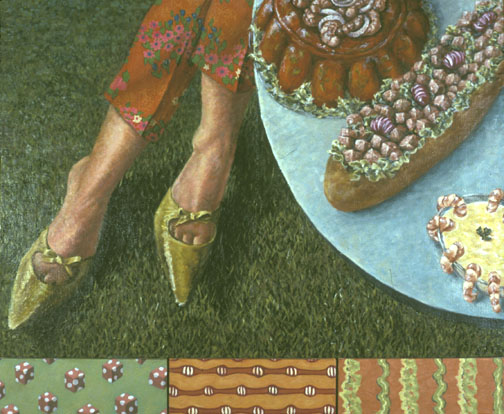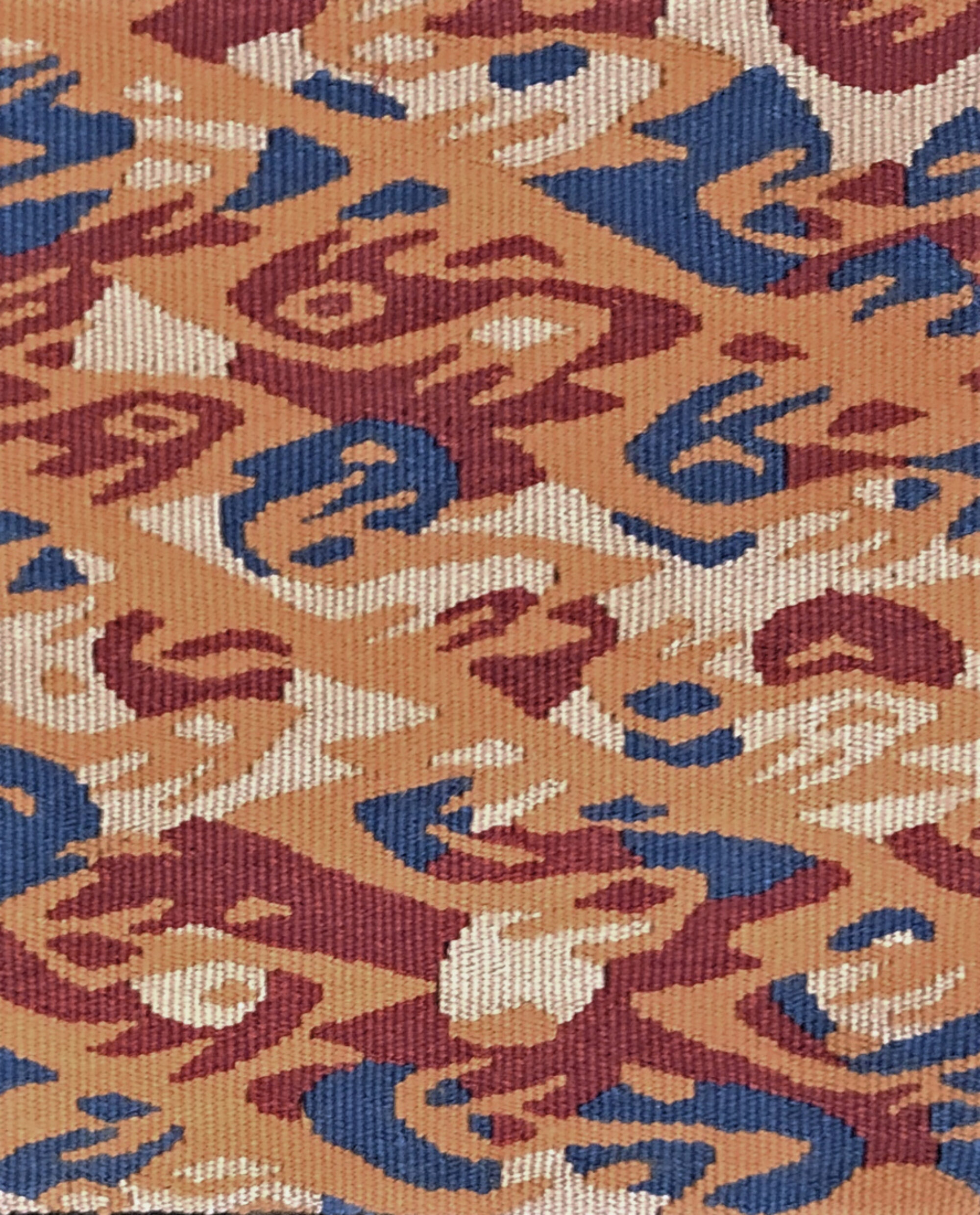This exhibition review was first published in the Winter 2006 issue of Fiberarts Magazine.
Domestic Bliss & Other Temptations
Ballard-Fetherston Gallery, Seattle, Washington, 2006
The heady, anything goes attitude that has characterized art in the late twentieth and early twenty-first centuries is marked by a proliferation of artistic genre. Painting, once considered to be the engine of artistic novelty and progress, now shares center stage with installations, video, performance and more. The prevalence of “multi media” work signals the collapse of boundaries between different media and the associated notions of purity championed by proponents of Modernism. It is within this intoxicating field of possibilities that Jane Richlovsky’s paintings on vintage textiles are situated.
Richlovsky, who lives and works in Seattle, collects printed curtains, tablecloths and other domestic textiles from second hand stores and stretches them on frames to serve as her canvas. Richlovsky incorporates the colorful patterns on the vintage textiles into her images by leaving parts of the fabric unpainted. In Arrange canapés; rest the vintage fabric shows through in the dresses of the three women whose steadfast attention focuses on a dazzling array of appetizers. Painted shadows create the illusion of the garments’ three-dimensional form.
One of the themes in Richlovsky’s work is that of women’s labor. In her series on Rosie the Riveter, pieces such as Indefinite Appointees examine the role women played as industrial laborers during World War II. For many women, the financial independence and experiences offered by working outside the home changed their lives forever. In Arrange canapés; rest Richlovsky presents the incredibly ornate and time consuming products of domestic labor, a sphere to which women were encouraged to return after the end of the war. The contradictions between women’s roles at home and at work fueled the agenda of the feminist movement.
Richlovsky’s work celebrates the ordinary, discarded domestic textiles that she alters. Many artists who work with found materials recognize a voice embedded in those materials, a lingering aura of their former use and previous owner. This suggestive presence elicits a certain melancholy that is associated with the passage of time. It also supplements the voice of the artist, gently reminding us that the past has valuable lessons to teach.
Richlovsky works not only with found textiles, but also with borrowed images. Most of her paintings are based on 1950s advertisements that she crops and manipulates. Advertising establishes a model for the ideal woman and the ideal domestic environment. It also provides an endless array of consumer products that promise cleanliness, attractiveness and happiness. Richlovsky manipulates advertisements in order to comment on the aims and methods of advertising. The dense, colorful and highly patterned surface in Arrange canapés; rest creates a dizzying effect, leaving us reeling with the thought of the whirling blenders and frantic knives that must have been responsible for such a dazzling array of culinary masterpieces. The diagonal crossing of the women’s arms, the oddly cropped composition, the deliberately tipped plane of the table surface and the strong value contrast create the frenzied atmosphere of party preparations. The incongruity between the women’s focused attention and the frivolity of their baroque gastronomic creations lends a comic aspect to the work, allowing us to laugh at the same time that we are dismayed by the model of women offered by advertising.
In many of her pieces Richlovsky juxtaposes panels of abstract patterning alongside larger figurative images. These panels echo the patterning of the vintage textile and offer a counterpoint to the hyperrealism of the painted image. The juxtaposition points out the somewhat tenuous line that exists between the more highly regarded abstraction of painting and the “mere” decoration of printed textiles. Richlovsky’s combination of abstraction and figuration involves a series of conscious choices that influence both the form and the content of the work. They create not only the visual impact of the image, but also the underlying cultural critique.

Dress and Serve on a Bed of Greens highlights the role of seduction in advertising. The tightly clad, slender legs and a pair of shoes that suggest fetish more than function are served up, as is the overly ornamental food, on a bed of greens. The close cropping calls attention to the ways in which advertising objectifies and sexualizes women.
Cropped images imply the world around them, the world that would complete the image. At the same time, they leave the question of what that world looks like unanswered. They are both allusive and illusive. Dress and Serve on a Bed of Greens is a skillfully crafted image. The sophisticated composition, the variety of patterning devices and the deliberate use of cropping serve both Richlovsky’s cultural commentary and her love of decorative patterning and formal invention.
A number of Richlovsky’s paintings focus on domestic appliances and tools such as irons, cake pans and the Electrolux. These paintings refer to women’s domestic labor but they also show off Richlovsky’s compositional and painting talents. Many of them, including Quicker, Hotter, Faster, feature reflections, which Richlovsky particularly enjoys painting. Shadows painted over the vintage fabric suggest the draping of the cloth over the ironing board. The diagonal lines, the sharply pointed iron and the unnatural tilting of the ironing board plane create a dynamic composition that animates what otherwise would be a formal and static image. The isolated hand symbolizes women’s role as domestic goddess, performing tasks with impeccably painted fingernails and the latest modern appliance.
Jane Richlovsky’s work is rich in complex interactions. The patterned fabric, the images painted on the fabric and the content of the painted images work together to create both a visual statement and cultural commentary. The strength of her work lies in the combination of intellectual content, technical expertise and a generous dose of humor.
